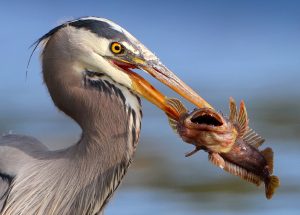6.1 General Features of Animals

Even though animals are incredibly diverse, they share common features that distinguish them from organisms in other kingdoms. All animals are eukaryotic, multicellular organisms, and almost all animals have specialized tissues (groups of similar cells that work together to carry out a specific function). Most animals are motile, at least during certain life stages. All animals are heterotrophic, ingesting living or dead organic matter. This form of obtaining energy distinguishes them from autotrophic organisms, such as most plants, which make their own nutrients through photosynthesis and from fungi that digest their food externally. Animals may be carnivores, herbivores, omnivores, or parasites. Most animals reproduce sexually. The offspring pass through a series of developmental stages that establish a determined body plan (shape), unlike plants, for example, in which the exact shape of the body is indeterminate.
Classification of Animals
Animals are classified into different phyla using a combination of physical traits and genetic data.

The first major division that you can see in the phylogenetic tree is based on body symmetry. Animals may be asymmetrical, radial, or bilateral in form (Figure 6.1.2). Asymmetrical animals are animals with no pattern or symmetry (Figure 6.1.2a); an example of an asymmetrical animal is a sponge. An organism with radial symmetry (Figure 6.1.2b) has a longitudinal (up-and-down) orientation: Any plane cut along this up–down axis produces roughly mirror-image halves. An example of an organism with radial symmetry is a sea anemone. Bilateral symmetry is illustrated in Figure 6.1.2c using a goat. The goat also has upper and lower sides to it, but they are not symmetrical. A vertical plane cut from front to back separates the animal into roughly mirror-image right and left sides. Animals with bilateral symmetry also have a “head” and “tail” (anterior versus posterior) and a back and underside (dorsal versus ventral).
Animals are often informally divided into two broad categories: invertebrates and vertebrates. Invertebrates are animals without a backbone, whereas vertebrates are animals that have a backbone. Scientists currently recognize about 35 different groups of animals (phyla) on Earth. Most of these groups only contain invertebrates. In fact, about 95% of all animal species are invertebrates. Although vertebrates, such as mammals, birds, and fish, are more familiar to us, they make up only a small part of the animal kingdom and all belong to just one phylum – Chordata.
Let’s explore the nine most diverse phyla of animals, starting with the invertebrates, by referring to Figure 6.1.3 below.

Knowledge Check
Text Description
- The ability to photosynthesize
- External digestion of food
- Eukaryotic, multicellular body structure
- Indeterminate body plan
- They have a circular shape with identical parts around a central axis
- They can be divided into right and left mirror-image halves
- They have no consistent shape or pattern
- They always have a backbone
- Animals photosynthesize like plants
- Animals externally digest food like fungi
- Animals ingest organic material internally
- Animals absorb minerals directly from the soil
- Vertebrates make up the majority of animal species
- Invertebrates all belong to the phylum Chordata
- Invertebrates lack a backbone and make up about 95% of animals
- All animals with bilateral symmetry are vertebrates
- Their method of digestion
- Their ability to reproduce
- Their overall shape and symmetry developed during early growth
- Their classification as vertebrate or invertebrate
Answers:
- c. Eukaryotic, multicellular body structure
- b. They can be divided into right and left mirror-image halves
- c. Animals ingest organic material internally
- c. Invertebrates lack a backbone and make up about 95% of animals
- c. Their overall shape and symmetry developed during early growth
OpenAI. (2025). ChatGPT. [Large language model]. https://chat.openai.com/chat
Prompt: Create 5 multiple-choice questions using the following content
“15.1 Features of the Animal Kingdom” from Biology and the Citizen by Colleen Jones is licensed under a Creative Commons Attribution 4.0 International License, except where otherwise noted. Modifications: Edited and reworded

